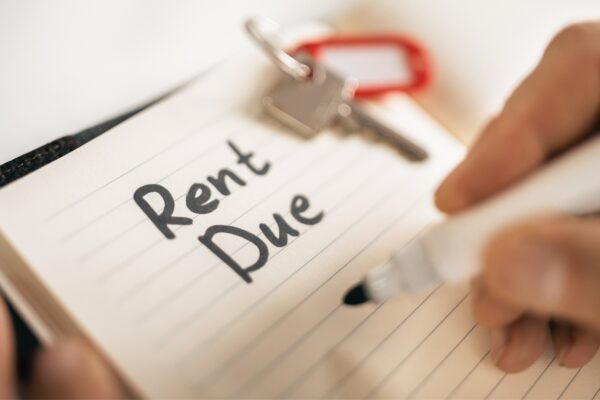The government is planning to scrap Section 21 as part of the Renters’ Rights Bill, but until that happens, landlords can still use it to regain possession of their property.
A Section 21 notice is different from a Section 8 notice as it lets you end an assured shorthold tenancy (AST) without giving a reason, as long as you follow the correct steps.
That said, getting it wrong can be a real headache. A simple mistake could mean delays, extra costs, or the notice being invalid, forcing you to start from scratch.
This guide will walk you through the step-by-step process of serving a Section 21 notice properly, so you can avoid legal pitfalls and make the process as smooth as possible.
Just a heads-up: This applies only to tenancies in England created on or after 1st October 2015.
- What is a Section 21 notice?
- Serving a valid Section 21 notice
- How can landlords serve a Section 21 eviction notice?
- What happens if the tenants don’t leave the property?
Use our free tool to easily serve a Section 21 notice in a few simple steps. Find Out More
What is a Section 21 notice?
A Section 21 notice is a formal notice (Form 6A) that a landlord serves on a tenant to end an assured shorthold tenancy (AST).
You can use this notice to end the tenancy on or after the fixed term ends, unless a break clause applies. You must give your tenants at least two months’ notice.
Unlike other eviction notices, Section 21 doesn’t require you to give a reason or show that your tenant is at fault. That’s why it’s often called a “no-fault” eviction.
If the tenant doesn’t move out by the specified date, the landlord can apply for accelerated possession proceedings, a paper-based court process to regain possession.
Although the government is planning to abolish Section 21 under the Renters’ Rights Bill, it’s still in place for now. That said, as a landlord, you must follow some strict rules for the notice to be valid, so getting it right is essential.
Serving a valid Section 21 notice
Landlords can only serve a Section 21 notice using Form 6A if they’ve met certain legal requirements.
To help you get it right, we’ve created a detailed checklist to make sure your eviction notice is valid under the Housing Act 1988 and that you serve Form 6A correctly. Click on each point to see how missing it could invalidate your notice.
If you want to be absolutely sure you’re following the right steps, you can also use our free Section 21 notice tool to guide you through the process with confidence.
A Section 21 notice cannot be served during the first four months of a tenancy. If you are serving the notice too early, it will be invalid.
You can only use Section 21 to end a tenancy after the fixed term has expired or in line with a valid break clause. If the notice period ends within the fixed term (and no break clause applies), the notice will not be valid.
Landlords must provide the latest version of the “How to Rent” guide to tenants at the start of the tenancy. This should be given as a printed copy or sent electronically if the tenant agrees.
If a deposit was taken, the prescribed information about how and where the deposit is protected must have been given to the tenant within 30 days of receipt. Failure to do so means you cannot serve a valid Section 21 notice until this is resolved.
If a deposit was collected, it must be registered with a government-backed scheme (DPS, TDS, or MyDeposits) within 30 days.
If the property has gas appliances, a valid Gas Safety Certificate must have been given to the tenant before they moved in and kept up to date throughout the tenancy.
Landlords must give tenants a valid EPC at the start of the tenancy. If you haven’t, your Section 21 notice will be invalid.
If the property is an HMO (House in Multiple Occupation) or is in a selective licensing area, the correct landlord licence must be in place.
If the local council has served a notice for serious repairs or safety issues, you cannot serve a Section 21 notice for at least six months.
If you have charged any unlawful fees (e.g. admin fees, referencing fees, or deposits above the legal cap), these must be fully refunded before serving a valid Section 21 notice.
After serving the notice, you should keep a record of how Form 6A was delivered. One easy way to do this is by filling in the certification of service form (N215).
If the tenants don’t leave by the date specified in the Section 21 notice, you can use the completed N215 and the original notice to apply for an accelerated possession order.
If your tenants don’t move out by the end of the notice period, you must start possession proceedings within four months – six months from the date you served the Section 21 notice.
How long is a Section 21 notice valid after it’s been served?
Once a landlord serves the two months’ notice using Form 6A, they have six months from the date it’s served to begin possession proceedings.
This means that Form 6A will be valid for up to six months. If the landlord hasn’t started the proceedings within that time, they’ll need to begin again and serve a new Form 6A.
You might also be interested in…
- All You Need to Know About Right to Rent Checks
- Guide to the Renters’ Rights Bill for Landlords 2025
- What Are the EPC Requirements for Landlords?
- Renting to Students: Guarantors, Advance Payments, HMO licence and more
- Holding Deposit, Tenancy Deposit, Rental Fees: Everything You Need to Know
How can landlords serve a Section 21 eviction notice?
Serving a Section 21 eviction notice isn’t just about filling out the right paperwork – it’s also about making sure the tenant actually receives it.
You can serve the notice in different ways, each with its own rules. Whether you post it, hand it over in person, or send it by email, you must follow the correct process to make sure you serve the notice properly.
1. Email
If you choose to send the notice by email, it will be considered delivered and received on the same day, as long as it is sent before 4:30 pm on a working day. If the email is sent after this time, it will be treated as received on the next working day.
Before sending a notice by email, you should first check the tenancy agreement to make sure that the tenants have agreed to receive notices this way.
In OpenRent’s assured shorthold tenancies (ASTs), there is a clause confirming that the tenants have agreed to receive notices via email.
So, if you’re using Rent Now to set up your tenancies, your tenants have already given their consent to this method of communication.
2. First-class mail
If you’re sending Form 6A by first-class post, it’s important to take steps to avoid any arguments about when or whether it was actually sent.
A simple way to do this is by asking for proof of posting from the post office. It’s also a good idea to take a photo of yourself handing the envelope over at the post office.
By law, the notice is considered to be served on the second day after it’s posted, provided it was sent on a working day.
If the second day falls on a non-working day (such as a weekend or bank holiday), service will be deemed to have occurred on the next available business day. For example, if you post the notice on a Friday, the second day would be Sunday. Since Sunday isn’t a working day, the notice will be considered served on Monday.
3. In-person delivery
This method involves physically giving the notice to the tenant, placing it in an envelope addressed to them at the property.
If you serve the document in person before 4:30 pm on a working day, it will be deemed that the tenants received notice on that same day. In any other scenario, it will be deemed received on the next working day.
Once again, you will need to keep evidence that you delivered the notice. You can achieve this by taking a timestamped photo of the Section 21 notice and another photo of it being handed to the tenant. It’s also not a bad idea to have a witness with you.
Alternatively, you can ask the tenant to sign a copy of the Section 21 notice as proof of receipt.
4. Left at address
Following the same process as described above, you can deliver the notice by leaving it at the property, like slipping it through the letterbox.
If you leave the notice at the property on a working day before 4:30 pm, it’s deemed as served on that very day. Otherwise, it’s treated as received on the next working day.
Once again, you’ll need to provide evidence for this method. This might include taking a photo with a timestamp of the Section 21 notice and another picture as you slide it through the property’s door.
If you use a courier, be sure to request a copy of the courier’s dispatch note as proof.
5. Recorded delivery
You can also send the notice via recorded delivery. If the tenant acknowledges and accepts the delivery, the notice is considered served on that day.
However, it’s worth mentioning that this method is generally not recommended. If the envelope gets returned as undelivered, then the notice won’t be considered served. This can create more uncertainty than most landlords prefer to deal with.
6. Process server
Last but not least, you can consider hiring a professional service, often referred to as a process server, to take care of serving legal notices. They’ll also provide proof of service that landlords can use in court if required.
Feel in control of your tenancies with our all-inclusive tenancy creation and management tool. Add property to OpenRent
What happens if the tenants don’t leave the property?
If the tenants don’t move out by the end of the two-month notice period in Form 6A, you’ll need to start possession proceedings at the county court to apply for an outright possession order via an accelerated possession order.
You can apply as soon as the two-month notice period ends, but you must do so within four months of the notice’s end date.
If the Section 21 notice is valid, the judge will grant possession of the property back to you. The judge will issue an outright possession order, which will include a ‘date for possession,’ usually set for two weeks later.
If the tenants are still in the property on the possession date, you’ll need to obtain a warrant for possession (Form N325) from the same county court that handled the case. This will allow you to proceed with eviction.
The final step is the actual repossession, which is carried out by appointing county court bailiffs or high court enforcement officers. This is the legal way to have the tenants removed from the property.



